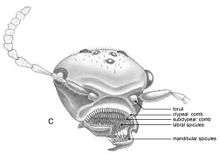Zigrasimecia
| Zigrasimecia tonsora Temporal range: Late Aptian to Early Cenomanian | |
|---|---|
 | |
| Zigrasimecia tonsora holotype | |
| Scientific classification | |
| Kingdom: | Animalia |
| Phylum: | Arthropoda |
| Class: | Insecta |
| Order: | Hymenoptera |
| Family: | Formicidae |
| Subfamily: | †Sphecomyrminae |
| Genus: | †Zigrasimecia |
| Species: | † Z. tonsora |
| Binomial name | |
| Zigrasimecia tonsora Barden & Grimaldi, 2013 | |
Zigrasimecia is an extinct genus of ant in the Formicidae subfamily Sphecomyrminae, and is currently placed in the tribe Sphecomyrmini.[1] The genus contains two described species: the type species Zigrasimecia tonsora[2] and Zigrasimecia ferox.[1] Both species are known from Middle Cretaceous fossils which were found in Asia.[2][1]
History and classification
Zigrasimecia is known from a solitary adult fossil, the holotype, specimen number JZC Bu-159. At the time of description, the specimen was residing in the private collection of James Zigras and only available for study through the American Museum of Natural History.[2] The holotype specimen is composed of a mostly complete dealate adult female which has been preserved as an inclusion in transparent chunks of deep yellow and relatively clear Burmese amber. The amber specimen was recovered from deposits in Kachin State, 100 kilometres (62 mi) west of Myitkyina town in Myanmar. Burmese amber has been radiometrically dated using U-Pb isotopes, yielding an age of approximately 99 million years old, close to the Aptian – Cenomanian boundary.[2]

The fossil was first studied by paleoentomologists Phillip Barden and David Grimaldi, both of the American Museum of Natural History.[2] Barden and Grimaldi's 2013 type description of the new genus and species was published in the online journal Zootaxa.[2] The genus name Zigrasimecia is a patronym which was coined as a combination of James Zigras' last name and -mecia which is a commonly used suffix in ant generic names. The specific epithet tonsora was derived from a combination of the Latin words "tonsor" meaning barber or hairdresser and "oris" meaning mouth.[2] Zigrasimecia is one of seven ant species described from Burmese amber and one of the five Burmese amber species placed in Sphecomyrminae. The other sphecomyrmin species are Haidomyrmex cerberus, Haidomyrmex scimitarus, Haidomyrmex zigrasi, and Sphecomyrmodes orientalis.[2]
Description
The Zigrasimecia female has a similar structure to species of Sphecomyrmodes. The mandibles have only two large teeth one subapical and one apical. In contrast, the clypeus of Zigrasimecia has a high number of denticles, about 30, and two short vertical rows of denticles. Zigrasimecia has mandibles which are half the length of Sphecomyrmodes and having a dense brush of spicule like setae. The broad, flattened head is 0.66 millimetres (0.026 in) in length and 0.76 millimetres (0.030 in) wide. The occeli are large while the eyes are smaller, protruding, and tear-drop shaped. The 1.42 millimetres (0.056 in) antenna have a total of 12 antennomeres, with flagellum composed of ten flagellomeres. The propodium sporting a slit like spiracle which faces to the rear. The metapleural gland has a large, crescent shaped opening and well developed metapleural bulla. The metasoma is mostly obscured by a large bubble. A large sting appears to be present.[2]
References
- 1 2 3 Vincent Perrichot (2014). "A new species of the Cretaceous ant Zigrasimecia based on the worker caste reveals placement of the genus in the Sphecomyrminae (Hymenoptera: Formicidae)". Myrmecological News 19: 165–169.
- 1 2 3 4 5 6 7 8 9 Barden, P.; Grimaldi, D. (2013). "A New Genus of Highly Specialized Ants in Cretaceous Burmese Amber (Hymenoptera: Formicidae)" (PDF). Zootaxa 3681 (4): 405–412. doi:10.11646/zootaxa.3681.4.5.
External links
 Media related to Zigrasimecia tonsora at Wikimedia Commons
Media related to Zigrasimecia tonsora at Wikimedia Commons